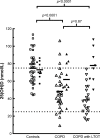The influence of disease severity and lifestyle factors on the peak annual 25(OH)D value of COPD patients
- PMID: 29731626
- PMCID: PMC5927355
- DOI: 10.2147/COPD.S156121
The influence of disease severity and lifestyle factors on the peak annual 25(OH)D value of COPD patients
Abstract
Background: The prevalence of individuals deficient in vitamin D (defined as a serum level of the stable metabolite 25(OH)D <50 nmol/L) is increasing in countries with low annual ultraviolet (UV) radiation and among individuals unable to perform outdoor activities, for example, COPD patients.
Objective: To assess the role of vitamin D deficiency, independently of seasonal variation, the peak annual value of 25(OH)D was measured in subjects with advanced COPD ± long-term oxygen therapy (LTOT) and lung healthy control subjects. A method to grade the individual annual UV light exposure was designed and tested.
Subjects and methods: Sixty-six Caucasians with advanced COPD (28 with LTOT) and 47 control subjects were included, and the levels of 25(OH)D were determined in late summer/early fall when the annual peak was assumed. Questionnaires about COPD symptoms, general health, lifestyle, dietary habits and QoL were used to collect data. Lung function tests and blood sampling were performed.
Results: The peak annual 25(OH)D of COPD subjects was significantly lower than in the control subjects, but there was no significant difference between COPD patients with and without LTOT. Ongoing vitamin D supplementation was the single most important intervention to maintain 25(OH)D levels ≥50 nmol/L. Among vitamin D-deficient COPD subjects, 25(OH) D correlated positively with forced expiratory volume in 1 second as % predicted, Modified British Medical Research Council score, blood oxygenation, food portion size, Mediterranean Diet Score and Ultraviolet Score.
Conclusion: Vitamin D deficiency was common among healthy individuals and COPD subjects. Peak annual 25(OH)D levels of COPD subjects correlated with clinically important outcomes. The present study emphasizes the need to routinely monitor vitamin D status among patients with advanced COPD and to consider to medicate those with vitamin D deficiency with vitamin D supplementation.
Keywords: chronic obstructive pulmonary disease; inflammation; long-term oxygen therapy; quality of life; ultraviolet score; vitamin D.
Conflict of interest statement
Disclosure HLP has received honoraria for advisory boards/lectures from AstraZeneca, Boehringer Ingelheim, Novartis, Takeda Nycomed, Almirall, Intermune and Roche. MK has received honoraria for lectures from AstraZeneca, Boerhinger Ingelheim, Novartis, Roche, Lilly and Pfizer. None of these disclosures influenced the present study in any way. The other authors report no conflicts of interest in this work.
Figures



Similar articles
-
Prevalence, determinants and clinical correlates of vitamin D deficiency in patients with Chronic Obstructive Pulmonary Disease in London, UK.J Steroid Biochem Mol Biol. 2018 Jan;175:138-145. doi: 10.1016/j.jsbmb.2017.01.019. Epub 2017 Feb 1. J Steroid Biochem Mol Biol. 2018. PMID: 28161533
-
Vitamin D deficiency is associated with impaired disease control in asthma-COPD overlap syndrome patients.Int J Chron Obstruct Pulmon Dis. 2015 Sep 24;10:2017-25. doi: 10.2147/COPD.S91654. eCollection 2015. Int J Chron Obstruct Pulmon Dis. 2015. PMID: 26451099 Free PMC article.
-
Vitamin D status and dietary intake in a Swedish COPD population.Clin Respir J. 2014 Jan;8(1):24-32. doi: 10.1111/crj.12030. Epub 2013 Jul 31. Clin Respir J. 2014. PMID: 23711108
-
Relative importance of summer sun exposure, vitamin D intake, and genes to vitamin D status in Dutch older adults: The B-PROOF study.J Steroid Biochem Mol Biol. 2016 Nov;164:168-176. doi: 10.1016/j.jsbmb.2015.08.008. Epub 2015 Aug 11. J Steroid Biochem Mol Biol. 2016. PMID: 26275945 Review.
-
Vitamin D deficiency: What does it mean for chronic obstructive pulmonary disease (COPD)? a compherensive review for pulmonologists.Clin Respir J. 2018 Feb;12(2):382-397. doi: 10.1111/crj.12588. Epub 2017 Jan 5. Clin Respir J. 2018. PMID: 27925404 Review.
Cited by
-
Association of serum vitamin D levels with disease severity, systemic inflammation, prior lung function loss and exacerbations in a cohort of patients with chronic obstructive pulmonary disease (COPD).J Thorac Dis. 2021 Jun;13(6):3597-3609. doi: 10.21037/jtd-20-3221. J Thorac Dis. 2021. PMID: 34277053 Free PMC article.
-
Skeletal Myosteatosis is Associated with Systemic Inflammation and a Loss of Muscle Bioenergetics in Stable COPD.J Inflamm Res. 2022 Aug 1;15:4367-4384. doi: 10.2147/JIR.S366204. eCollection 2022. J Inflamm Res. 2022. PMID: 35937916 Free PMC article.
-
Vitamin D status in patients with chronic obstructive pulmonary disease at Chris Hani Baragwanath Hospital, Johannesburg, South Africa.Afr J Thorac Crit Care Med. 2024 Oct 14;30(3):e1041. doi: 10.7196/AJTCCM.2024.v30i3.1041. eCollection 2024. Afr J Thorac Crit Care Med. 2024. PMID: 39628769 Free PMC article.
-
Gender Differences in Vitamin D Status and Determinants of Vitamin D Insufficiency in Patients with Chronic Obstructive Pulmonary Disease.Nutrients. 2023 Jan 13;15(2):426. doi: 10.3390/nu15020426. Nutrients. 2023. PMID: 36678297 Free PMC article.
-
Applying the Rome Proposal on Exacerbations of Chronic Obstructive Pulmonary Disease: Does Comorbid Chronic Heart Failure Matter?Int J Chron Obstruct Pulmon Dis. 2023 Sep 19;18:2055-2064. doi: 10.2147/COPD.S425592. eCollection 2023. Int J Chron Obstruct Pulmon Dis. 2023. PMID: 37744733 Free PMC article.
References
-
- Jones PW. Health status and the spiral of decline. COPD. 2009;6(1):59–63. - PubMed
-
- Mathers CD, Boerma T, Ma Fat D. Global and regional causes of death. Br Med Bull. 2009;92:7–32. - PubMed
-
- Hallin R, Koivisto-Hursti UK, Lindberg E, Janson C. Nutritional status, dietary energy intake and the risk of exacerbations in patients with chronic obstructive pulmonary disease (COPD) Respir Med. 2006;100(3):561–567. - PubMed
-
- Schols AM, Ferreira IM, Franssen FM, et al. Nutritional assessment and therapy in COPD: a European Respiratory Society statement. Eur Respir J. 2014;44(6):1504–1520. - PubMed
-
- Fonseca Wald ELA, van den Borst B, Gosker HR, Schols AMWJ. Dietary fibre and fatty acids in chronic obstructive pulmonary disease risk and progression: a systematic review. Respirology. 2014;19(2):176–184. - PubMed
MeSH terms
Substances
LinkOut - more resources
Full Text Sources
Other Literature Sources
Medical

